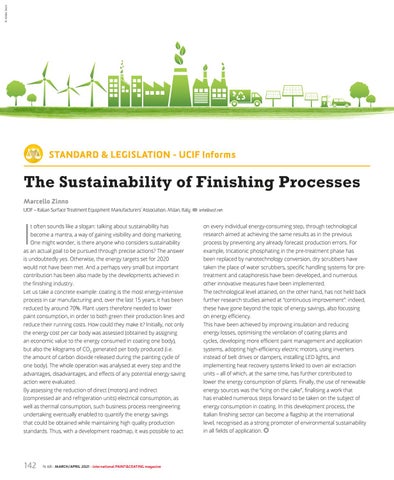© Adobe Stock
STANDARD & LEGISLATION - UCIF Informs
The Sustainability of Finishing Processes Marcello Zinno UCIF – Italian Surface Treatment Equipment Manufacturers’ Association, Milan, Italy
I
info@ucif.net
t often sounds like a slogan: talking about sustainability has
on every individual energy-consuming step, through technological
become a mantra, a way of gaining visibility and doing marketing.
research aimed at achieving the same results as in the previous
One might wonder, is there anyone who considers sustainability
process by preventing any already forecast production errors. For
as an actual goal to be pursued through precise actions? The answer
example, tricationic phosphating in the pre-treatment phase has
is undoubtedly yes. Otherwise, the energy targets set for 2020
been replaced by nanotechnology conversion, dry scrubbers have
would not have been met. And a perhaps very small but important
taken the place of water scrubbers, specific handling systems for pre-
contribution has been also made by the developments achieved in
treatment and cataphoresis have been developed, and numerous
the finishing industry.
other innovative measures have been implemented.
Let us take a concrete example: coating is the most energy-intensive
The technological level attained, on the other hand, has not held back
process in car manufacturing and, over the last 15 years, it has been
further research studies aimed at “continuous improvement”: indeed,
reduced by around 70%. Plant users therefore needed to lower
these have gone beyond the topic of energy savings, also focussing
paint consumption, in order to both green their production lines and
on energy efficiency.
reduce their running costs. How could they make it? Initially, not only
This have been achieved by improving insulation and reducing
the energy cost per car body was assessed (obtained by assigning
energy losses, optimising the ventilation of coating plants and
an economic value to the energy consumed in coating one body),
cycles, developing more efficient paint management and application
but also the kilograms of CO2 generated per body produced (i.e.
systems, adopting high-efficiency electric motors, using inverters
the amount of carbon dioxide released during the painting cycle of
instead of belt drives or dampers, installing LED lights, and
one body). The whole operation was analysed at every step and the
implementing heat recovery systems linked to oven air extraction
advantages, disadvantages, and effects of any potential energy saving
units – all of which, at the same time, has further contributed to
action were evaluated.
lower the energy consumption of plants. Finally, the use of renewable
By assessing the reduction of direct (motors) and indirect
energy sources was the “icing on the cake”, finalising a work that
(compressed air and refrigeration units) electrical consumption, as
has enabled numerous steps forward to be taken on the subject of
well as thermal consumption, such business process reengineering
energy consumption in coating. In this development process, the
undertaking eventually enabled to quantify the energy savings
Italian finishing sector can become a flagship at the international
that could be obtained while maintaining high quality production
level, recognised as a strong promoter of environmental sustainability
standards. Thus, with a development roadmap, it was possible to act
in all fields of application.
142
N. 68 - MARCH/APRIL 2021 - international PAINT&COATING magazine
